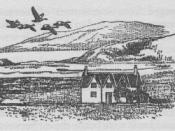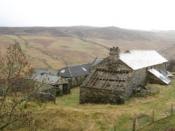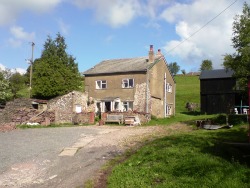Tair-Ffynnon



TAIR-FFYNNON
| Tair-Ffynnon is Welsh for Three Springs—though so far we’ve only found a couple (delicious, ice-cold and, as it turned out, laced with E. Coli). They are the reason the place is here. Possibly it started life as a ty unnos or ‘one-night’ cottage: by long Welsh tradition, if you built a dwelling on common land in a single night, so that smoke rose from the chimney by dawn, you could claim both the building and the land around it to the distance of four | axe-throws (about five acres). In its first incarnation the place was probably a dry-stone walled and bracken-thatched hovel, which was gradually improved down the years. Alternatively, it could have been a hafod, one of the shepherd’s shelters found all over the hills and mountains of Wales, where in the summer months sheep were brought for grazing. |
   |
I’d been dreaming of a rural hideway for as long as I could remember. And in my mind, I knew precisely what I was after. It would be a remote, whitewashed stone cottage with a sagging roof of mossy stone slates, up a long, rocky track. Inside would be a sitting room lined with books, and battered old leather armchairs, a threadbare carpet and a blazing log fire. The place would have elements of Gavin Maxwell’s Camusfearna (his cottage on the West Coast of Scotland in Ring of Bright Water), Uncle Monty’s Lake District retreat in the film Withnail and I, and Shackleton’s hut at the South Pole, with its tin stove pipe, cosy bunks and (yes, let us not forget) plentiful wooden packing cases of canned lobster soup and vintage claret. |
It had to be somewhere properly wild: mountains or moorland—walking country—where the wind howled and the rain lashed, somewhere that would be cut off for weeks by snow in winter, as an antidote to the airless, Tupperware skies of London. In this place, after long walks in the hills (wearing sturdy, red-laced boots), worries could be soaked away in deep baths while sipping whisky (not that I liked whisky) while savouring the sound of the weather hammering the windows. It seemed a straightforward enough fantasy, yet finding it had proved anything but. Chapter 1, Walking Country |
| When we first saw the place, it wore the guise it had acquired in the 1970s: a stone cottage subsumed into a modernised box. But nothing could detract from the setting. | Hopelessly in love, we bought Tair-Ffynnon in 2002 and have gradually been trying to make it sit more comfortably in its setting ever since. |


